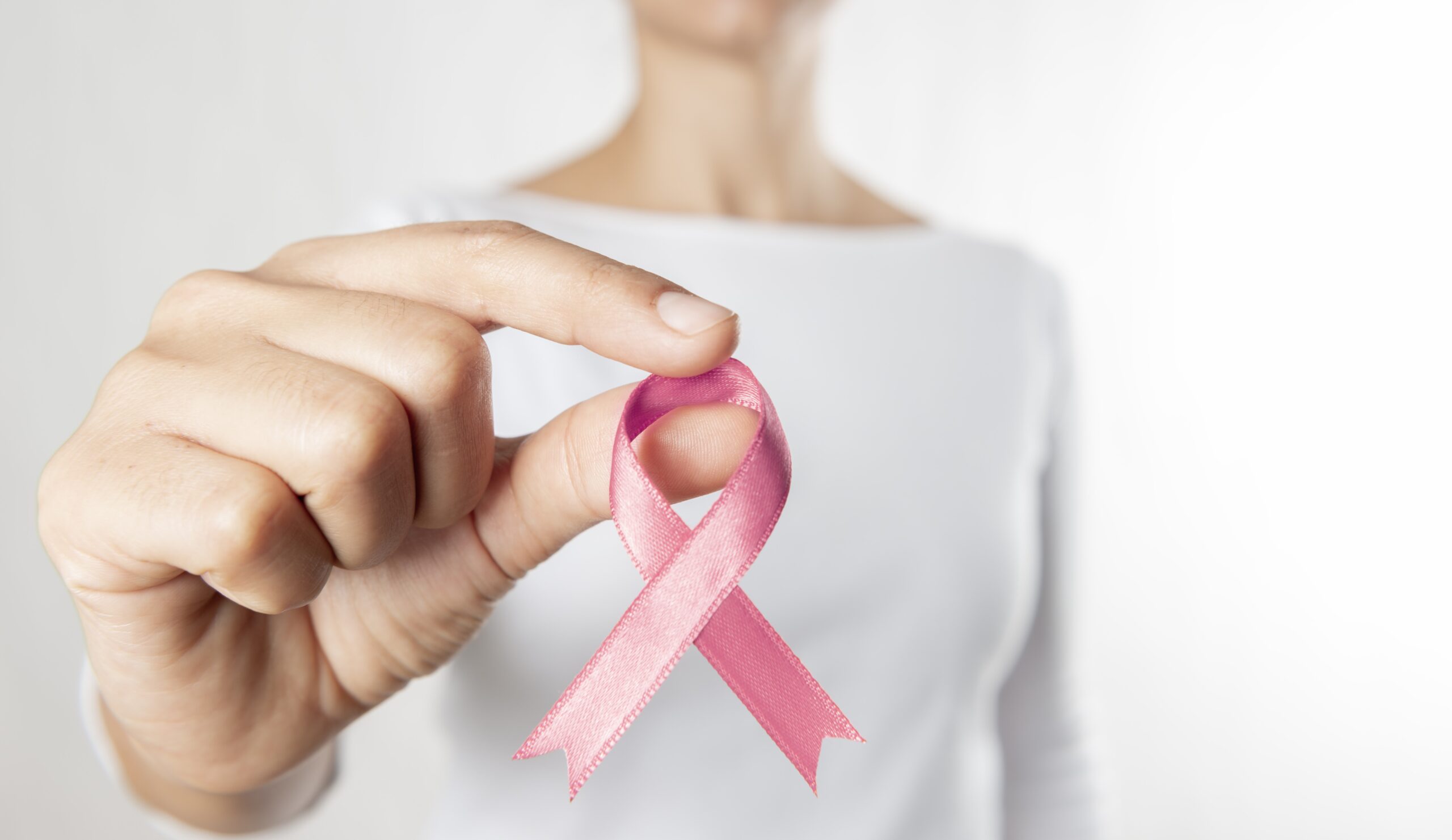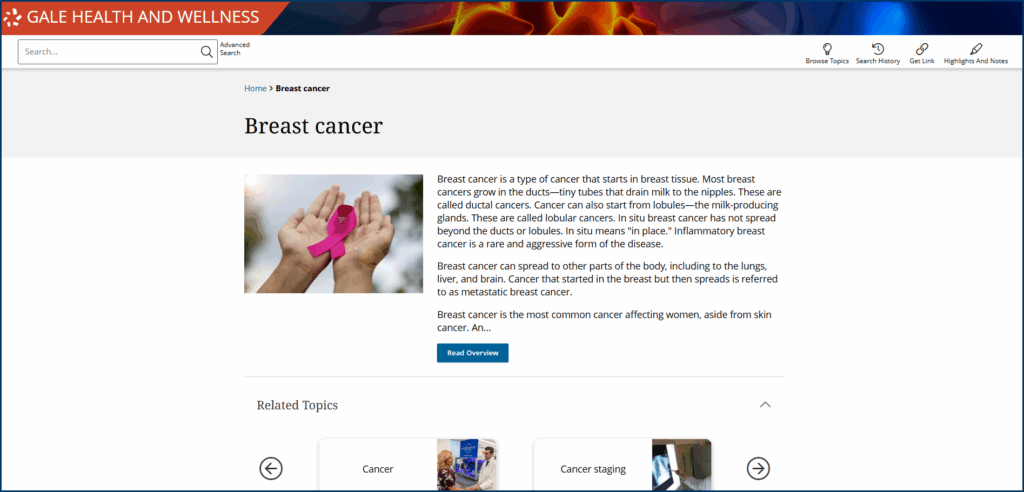A breast cancer diagnosis can leave even the most grounded person feeling overwhelmed. There’s medical terminology to decipher, treatment options to consider, and further testing to schedule—often before there’s time to fully process the diagnosis. Doctors and care teams lead the way in treatment decisions, but public libraries can help patrons make sense of new terminology and treatment options in a more familiar setting.
With Gale Health and Wellness, libraries can direct patrons to trusted, plain-language resources available on the platform’s breast cancer topic page, which explain what to expect. For those facing a recent diagnosis, that knowledge can provide a source of dignity and confidence, making it easier to participate in conversations about their care.
Making Sense of Treatment Terminology
After a breast cancer diagnosis, one of the first hurdles is learning the language. Knowing the basics—especially stage and grade—can help make sense of what the diagnosis means and what comes next.
- Stage 0 – Non-invasive: Cancer cells are confined to the ducts or lobules and haven’t spread to the surrounding breast tissue. This includes conditions like ductal carcinoma in situ.
- Stages I–III – Invasive but localized or regionally spread: Cancer has broken through surrounding tissue and may involve nearby lymph nodes, but it hasn’t spread to distant organs. Invasive ductal carcinoma (IDC) accounts for about 80% of diagnoses.
- Stage IV – Metastatic: In advanced cases, cancer cells can travel through the bloodstream or lymphatic system to other organs, such as the bones, lungs, or liver.
Where staging focuses on the location of the cancer, grading examines the type of cancer it is. By examining how closely cancer cells resemble healthy ones, pathologists can estimate how aggressively the tumor is likely to behave. The less the cells resemble normal breast tissue, the more likely they are to grow and spread rapidly.
- Grade 1 (low grade): Cancer cells still resemble healthy cells and tend to grow slowly.
- Grade 2 (intermediate grade): Cells appear more abnormal and grow at a moderate rate.
- Grade 3 (high grade): Cells look very different from normal cells, often growing and dividing more quickly.
Other Classification Factors
Some breast cancers grow in response to hormones like estrogen or progesterone. These are referred to as hormone receptor–positive (or ER+ and PR+) cancers. They’re often treated with medications that block those hormones to slow the cancer’s growth.
Doctors also test for HER2, a protein that helps cells grow and divide. Cancers that produce too much of this protein are known as HER2-positive. These tumors tend to grow quickly, but they often respond well to targeted medications that specifically block HER2 signals.
If the tumor doesn’t have hormone receptors and doesn’t produce extra HER2, it’s called triple-negative breast cancer (TNBC). This subtype tends to be more aggressive and more challenging to treat, since hormone therapy and HER2-targeted drugs won’t work.
Common Treatment Options
There is no one-size-fits-all treatment plan. Instead, decisions are based on a wide range of factors, including the patient’s health and personal preferences. Oncologists will work to put together a treatment plan that often combines several different methods to give patients the best chance of beating the cancer.
- Surgery is often a first-line treatment option to remove the tumor. A lumpectomy removes the cancer and a small margin of tissue, while a mastectomy removes the entire breast. The surgeon may also remove or biopsy surrounding lymph nodes to check for spread.
- Radiation therapy destroys any cancer cells that remain after surgery using high-energy rays. It’s often recommended after a lumpectomy or for patients with higher-risk disease.
- Chemotherapy involves either oral or intravenous drugs that kill fast-growing cells throughout the body. In some cases, doctors recommend starting with chemotherapy to make the tumor smaller, which can lead to better results during surgery.
- Hormone (endocrine) therapy uses medications like tamoxifen and aromatase inhibitors to block hormones or lower hormone levels, thereby slowing or stopping tumor growth in ER+ or PR+ cancers. Targeted therapy uses medicines like trastuzumab to slow the production of the HER2 protein.
- Immunotherapy trains the body’s natural defenses to better identify cancer cells and respond more forcefully, offering a new line of treatment for aggressive subtypes of breast cancer, including TNBC.
Starting the Conversation: Questions to Ask the Doctor
Even with access to reliable information, it can be challenging to know what to ask once a diagnosis has been delivered. One of the simplest ways libraries can support patrons at this stage is by helping them feel more prepared to discuss their care.
Encourage patrons to write their questions down ahead of time and, if possible, bring someone with them to take notes. Even a short list of questions can provide structure and a sense of control during an otherwise uncertain process.
Libraries may want to share this list as a handout or online resource—ideally paired with links to Gale Health and Wellness articles that explain the terms, procedures, and treatment options mentioned below. That added context can help patrons better understand why these questions matter, so they can approach appointments feeling more informed.
- What type of breast cancer do I have?
- What stage and grade is it?
- Has it spread beyond the breast or nearby lymph nodes?
- What additional tests do I need before we decide on a treatment plan?
- Is my cancer hormone receptor–positive (ER+/PR+) or HER2-positive?
- What are my treatment options based on this diagnosis?
- What are the risks and side effects of each treatment?
- Should I consider genetic testing?
- Is this cancer likely to respond to targeted therapies or hormone treatment?
- Do I need to begin treatment right away, or is there time to get a second opinion?
- Are there lifestyle changes I should make during treatment to support my health?
Supporting a Loved One with Breast Cancer
When someone you care about is diagnosed with breast cancer, you want to be supportive—but the role of a caregiver or close friend can be challenging. Libraries can also reach these community members with reliable health information that helps people stay present during a difficult time.
The following ideas are designed to help caregivers offer support without feeling overwhelmed by what to say or do.
Learn About the Diagnosis
Understanding your loved one’s diagnosis can help you provide a steadier presence in their life. If they mention terms like “HER2-positive” or “lymph node involvement,” looking them up with Gale Health and Wellness can provide clarity without placing the burden on them to explain. Not everyone wants to talk through the technical details of their diagnosis. Let them lead, and avoid turning your curiosity into a quiz.
Offer Specific, Practical Help
Instead of saying, “Let me know if you need anything,” suggest something tangible. Try:
- “Would it help if I picked the kids up from school this week?”
- “I’m free Thursday. Can I drive you to treatment?”
- “Want help sorting out insurance paperwork or setting up a calendar?”
Even small things—such as dropping off food or handling a phone call—can make a significant difference when someone is exhausted from appointments or side effects.
Learn to Listen
When someone you care about is diagnosed with breast cancer, it’s natural to want to help. You may feel the urge to suggest solutions or share stories about others who have gone through something similar. However, what often matters most is being willing to listen to them as they process the information—whether that’s talking through fears and frustrations, or not talking about cancer at all. Simply being present can be more meaningful than any advice.
It also helps to be mindful of the language you use, avoiding phrases like “Everything happens for a reason” or “Just stay positive.” These kinds of statements can feel dismissive and may unintentionally suggest that they’re handling things the “wrong” way.
Take Care of Yourself, Too
Even when you’re grateful for the chance to be supportive, it’s common to feel overwhelmed or emotionally stretched—especially if you’re juggling other responsibilities.
Take some time to read up on caregiver burnout, then carve out space for yourself to decompress. Those choices aren’t selfish, even when they feel that way. You have to tend to your own needs if you want to be better equipped to show up for someone else.
This is the second installment in a two-part series. Click here to read the previous blog post on screening information and risk factors associated with breast cancer.
Contact your local Gale sales representative to learn more about Gale Health and Wellness, and how it can help your library meet patrons’ needs with credible, approachable health content for every stage of life.


